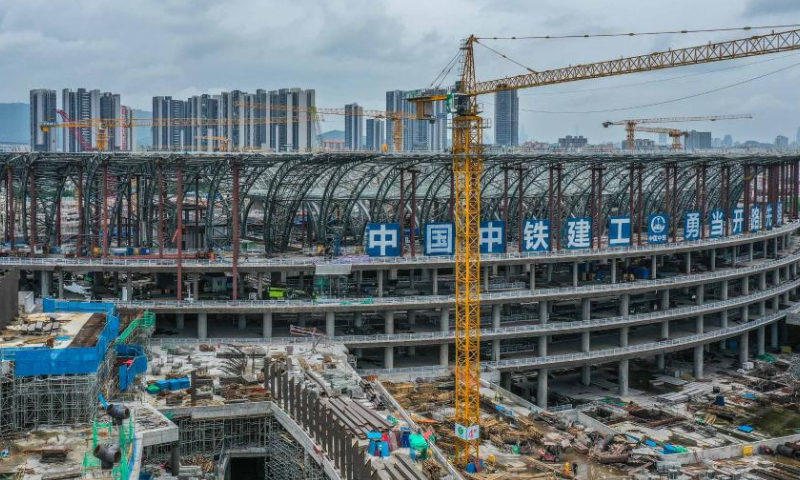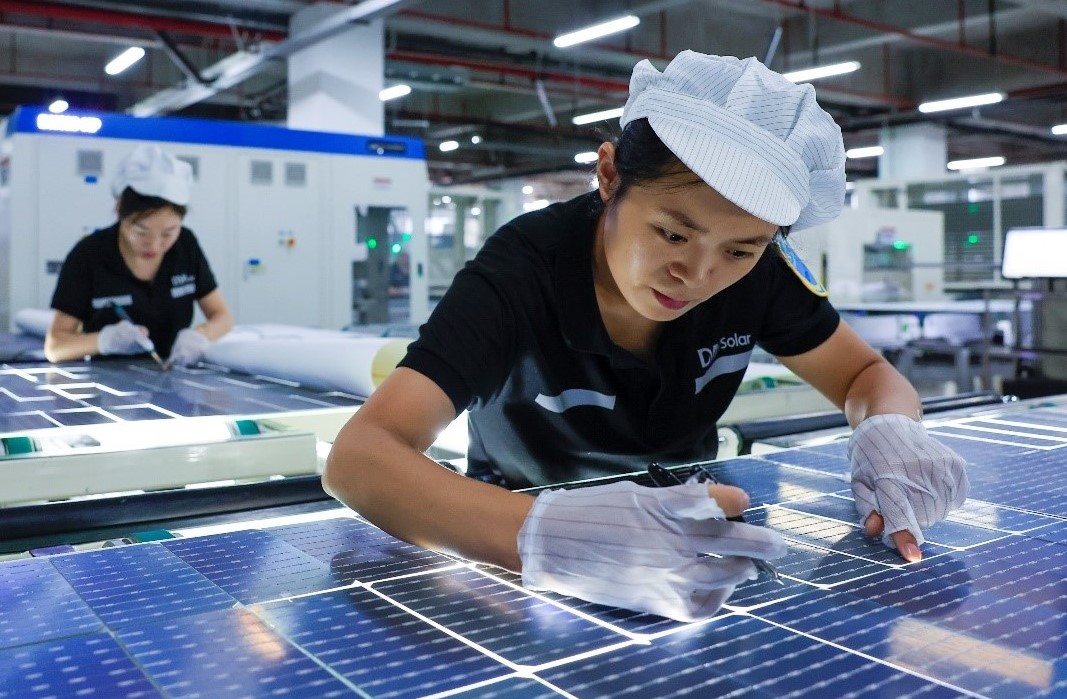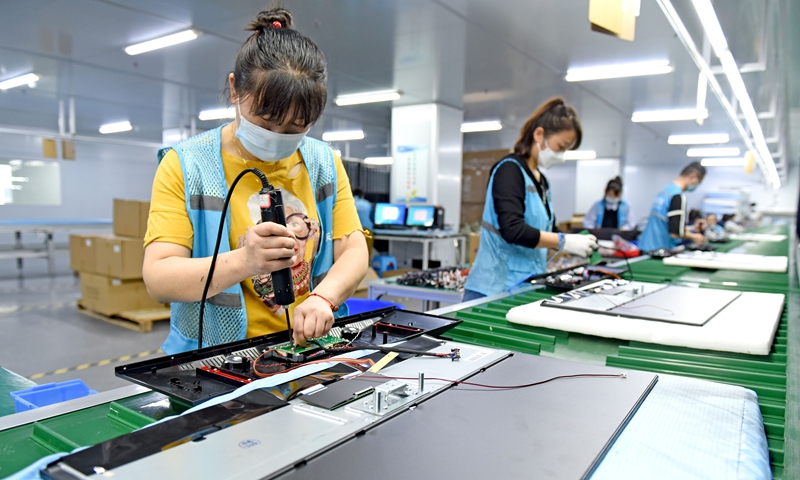1
Key projects in full swing across China, set to boost economic recovery

Major infrastructure projects across China are being carried out in full swing during what's known as "Golden September, Silver October," usually a high point for the construction sector, as the country is boosting infrastructure investment as part of a broad effort to stabilize the economy.
Thanks to policy initiatives that place much emphasis on the role of infrastructure expansion on economic growth, investment in infrastructure is expected to maintain high-speed growth of about 10 percent this year and help boost economic recovery, an economist said on Tuesday.
Pointing to the infrastructure boom, five of China's top state-owned construction firms, including China State Construction Engineering Corp (CSCE), China Communications Construction Co and China Railway Construction Corp, saw their new infrastructure contracts hit 3.9 trillion yuan ($563.1 billion) in the first half of the year, up 26.4 year-on-year, the China Securities Journal reported, citing Guosheng Securities.
China Railway Construction Corp told the Global Times on Tuesday that it aims to scientifically and rationally carry out construction, with breakthroughs in a batch of key projects.
Closure has been completed on the Jinhai Avenue Bridge, China's first multi-tower road-rail cable bridge, according to the group. The Jiuwandashan No.4 tunnel in Huanjiang Maonan Autonomous County, South China's Guangxi Zhuang Autonomous Region, was drilled through in August, marking the completion of all 108 tunnels of the Guiyang-Nanning high-speed railway line, it said.
Stated-owned construction giant CSCE said in a statement sent to the Global Times on Tuesday that the company aims to align its operations with the macroeconomic environment to keep a fast pace of rolling out projects.
The group has ramped up its ability to study the central government's support policies and grasp related opportunities, and its local branches closely follow up on opportunities stemming from central government budget investment and projects supported by special-purpose local government bonds.
CSCE said it has been improving in-house efficiency in pushing a project down the approval pipeline in a faster manner.
The share of housing projects dropped in its total contracted value by 12.3 percentage points in the first half of 2022, but the share of industrial complex projects rose by 5.1 percentage points, and that of commercial office buildings by 0.8 percentage points, according to the statement.
Localities such as Hangzhou in East China's Zhejiang Province, Tangshan in North China's Hebei Province and Haikou in South China's Hainan Province have launched key projects to seize the opportunity of the peak season for the construction sector.
On Friday, Haikou held a launch ceremony for a third batch of 30 key projects covering sectors including infrastructure, public services and environmental protection, with total investment of 17.4 billion yuan, according to the local government website.
The remarkable progress in the country's key infrastructure projects comes as the authorities channel more financial support into the sector amid national efforts to catalyze domestic demand and sustain an economic recovery.
China's investment in water infrastructure through a mix of bank loans and social capital this year has reached a record high of 238.8 billion yuan, with 19,000 new projects in progress, the Ministry of Water Resources told a press conference on Tuesday.
To speed up the construction of key projects, the quota of "policy-backed and development-oriented financial instruments" will be increased in accordance with local demand, and projects where construction started in the first half of the year will also obtain support, according to a State Council meeting on Thursday.
The instruments are designed to grant financial support for key projects by playing a greater guiding role, without resorting to massive stimulus or excessive money supply, according to the meeting.
Earlier this month, the quota for the tools was expanded by another 300 billion yuan to better fund major infrastructure projects. Prior to this, a total of 300 billion yuan had already been allocated via such instruments, covering more than 900 projects, according to the People's Bank of China, the central bank.
Thanks to these multi-pronged efforts, investment in infrastructure gained 7.4 percent year-on-year in the first seven months of the year, according to data from the National Bureau of Statistics.
With policy incentives and accelerated construction of key infrastructure projects across the country, the growth rate of infrastructure investment is expected to further accelerate to 10 percent or higher in the second half of the year, Cao Heping, an economist at Peking University, told the Global Times on Tuesday.
While taking advantage of favorable policies to accelerate the construction of key projects, domestic enterprises should also expand new infrastructure such as 5G and smart cities to play a larger role in promoting technological transformation and contributing to the stable recovery of the economy, said Cao.
By GT staff reporters
2
China 'key' to global green transition

*Employees work at a photovoltaic panel production unit in Hefei, Anhui province, on Sept 13, 2022. [Photo by Zhao Ming/for China Daily]
Nation's role in world's new power system highlighted by experts, insiders
China's advances in new energy development have won it the opportunity to lead the creation of international standards for new power systems, which will further accelerate the global transition to a low-carbon energy structure, experts said.
The new power system takes wind, solar, nuclear, biomass and other new energies as mainstays while fossil fuels will serve as supplements.
The comments came after the International Electrotechnical Commission recently proposed for China to lead in formulating the global standard framework of core technologies in the world's first new power system, and to accelerate low-carbon transition of the energy sector.
The commission said China has led the world in terms of new energy installed capacity and power generation for many years. The country's industry scale and market size of wind power, photovoltaics and lithium batteries have also ranked first in the world.
China's role in the research of the framework is key to the global energy transition, it said.
"With China's plan to scale up wind and solar power installations in the Gobi Desert and other arid areas, as well as the country's commitment to peak carbon emissions by 2030 and reach carbon neutrality by 2060, the country will see an increasing proportion of new energies used for power generation," said Lin Boqiang, head of the China Institute for Studies in Energy Policy at Xiamen University in Fujian province.
"Different from fossil fuels, new energy power generation poses higher requirements for the safe and stable operation of the power system because most new energies are intermittent resources, which experience rapid and random changes that make it hard for stable and steady power generation, causing volatility in voltage and frequency disturbances in grid operation. As a result, it is necessary to develop new power systems to meet growing demand buoyed by increasing new energy installations," Lin said.
The China Electricity Council said by the end of July, total installed capacity of non-fossil energy was 1.19 billion kilowatts, up 14.7 percent year-on-year, accounting for 48.3 percent of the total.
Orient Securities said with extreme weather posing bigger challenges, expanding new energy in power generation and continuous changes in the power consumption, construction of new power systems will be imminent and the industry reform is likely to accelerate in the second half.
The establishment of new power systems will spur demand for smart power networks, virtual power plants and power trade, and boost investment in these sectors, it said.
Recently, the State Grid Corp's Zhejiang branch cooperated with the local financial department and co-launched a project that grants smart grid developers easier access to loan products.
Zhejiang Daily said an estimated 20 billion yuan ($2.89 billion) has been arranged to this end, and related application procedures have been facilitated.
Li Gengfeng, a professor at Xi'an Jiaotong University, told China Energy News that China's first regional new power system will come soon and the industry is likely to see an accelerated pace of reform in the second half.
New energies will replace fossil fuels and become the major source of power generation in northwestern areas in 2022 thanks to the nation's efforts in the areas. State Grid's northwest branch will boast a power network that has the largest new energy installations, playing a major role in building the nation's first new power system, Li said.
Lin from Xiamen University said wind power and photovoltaic energy will take up the largest part of the new power system. Other major parts of the system include electric vehicles, power storage, hydropower, smart grid, and carbon capture and storage (CCS).
Lin said EVs will ultimately replace those powered by gasoline. The promotion of the smart grid and power storage will help mitigate the fluctuations in new energy power generation and transmission, and CCS will help ensure the goal of carbon neutrality as the new power systems require a certain proportion of fossil fuels that will produce emissions.
"China's new energy development is on a fast track. With more support from the government and the capital market in the pipeline, China is very likely to maintain its lead in new energy development."
Media Source: China Daily
3
China to augment 200 SME industrial clusters, says MIIT

*Workers manufacture display panels on an assembly line in Huainan High-Tech Industrial Development Zone in East China's Anhui Province, on April 24, 2022. Photo: VCG
China's Ministry of Industry and Information Technology (MIIT) announced support measures on Tuesday that aim to create 200 industrial clusters of small and medium-sized enterprises (SMEs) during the 14th Five-Year Plan (2021-25) period, while guide and cultivate growth of such industries at the provincial level.
Under the measures, local authorities are urged to designate industries where the region has an advantage, and they will cultivate the enterprises to help fill gaps in industry chains, according to a notice issued by the MIIT.
The localities are encouraged to promote synergies between big enterprises and SMEs, and support SMEs' industrial clusters to participate in the advanced manufacturing.
More measures will be announced to increase the sector' innovation ability, such as promoting SMEs to establish innovation cooperation with universities, institutes and other companies, read the notice.
Localities are also urged to promote digital upgrading and accelerate green low-carbon transformation of local industrial clusters.
The latest policy adds to a flurry of muscular government support for SMEs - a significant force in stabilizing employment and promoting the country's private economy - amid economic headwinds and China's push for innovation and technology self-sufficiency.
"The policy conspicuously aims to leverage regional resources and market mechanisms to shore up the development of SMEs, as smaller firms have been subject to pressure due to declining foreign demands and the global economic slowdown," Hu Qimu, chief research fellow at the Sinosteel Economic Research Institute, told the Global Times on Tuesday.
Hu said that boosting SME industrial clusters will produce "a radiation effect" to accelerate regional development and drive up employment.
China's leadership has called for more efforts to support SMEs so as to promote innovation and foster more "little giant" companies, according to a letter the leadership sent to a conference on the development of such enterprises that opened last Thursday in Nanjing, capital of East China's Jiangsu Province.
China has designated about 9,000 "little giants," or SMEs that specialize in strategic sectors like advanced manufacturing and semiconductors, according to a report issued by the MIIT. Their operating income reached 3.7 trillion yuan ($532 billion) in 2021, surging 31.5 percent year-on-year.
China aims to nurture 10,000 "little giant" companies during the 14th Five-Year Plan period, and the authorities have published four lists of companies designated as "little giant" companies.
Media source: Global Times
4
Full moon center of attention at Dazhong Temple Ancient Bell Museum event

*The fashion show Photo: Courtesy of Beijing Yanshan Press
A series of events to help people better enjoy the tradition of admiring the full moon during the Mid-Autumn Festival was held at Beijing's Dazhong Temple Ancient Bell Museum on Saturday night.
In China, the Mid-Autumn Festival has always been a day for family reunion as family culture is an important part of the foundation of traditional Chinese culture.
For the festival, the event, hosted by the museum and the Beijing Yanshan Press, included traditional cultural programs and a fashion show that covered everything from traditional clothing to more modern ones. In the traditional clothing section, children dressed up in modern times takes on clothing in the Han (206BC-AD220), Tang (618-907) and Song (960-1279) dynastieswith the aim of showcasing the styles of China's various time periods.
The event to celebrate the Mid-Autumn Festival ended with the ringing of the Yongle Great Bell.
It offers three bell-ringing experiences during with visitors could strike the museum's huge Buddha bell, which was cast during the Yongle period of the Ming Dynasty (1368-1644). The bells were rung a total of 108 times, an auspicious number, during the event.
Media Source: Global Times